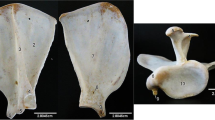Abstract
Supernumerary digits on roe deer (Capreolus capreolus) have been recorded over many decades in Germany. The case described in this communication is believed to be only the second documented example from the UK. A right hind foot of a buck had three equally developed digits arising from a metatarsal that trifurcated.



Similar content being viewed by others
References
Banwell DB (1999) Polydactylism in New Zealand red deer and related species. Deer 11:40–42
Braunschweig A von (1982) Abnormitäten an Läufen bei Rehwild. Wild und Hund 1982 (6):34–38
Chapman D, Chapman NG (1969) The use of sodium perborate tetrahydrate (NaBO3.4H2 O) in the preparation of mammalian skeletons. J Zool Lond 159:522–523
Daniel MJ (1967) Polydactyly in red deer, Cervus elaphus Linné, 1758, in New Zealand. Säugetierkundl Mitt 15:149–155
Davidson MM (1971) A case of polydactylism in sika deer in New Zealand. J Wildl Dis 7:109–110
Donaldson-Webster RJ (1995) Deformed roe buck. Deer 9:540
Gäbler H (1961) Abnormitäten beim Rehwild im Jahre 1960. Z Jagdwiss 7:32–34
Horsefield T (1993) Bent-nosed deer. Deer 9:77
Miller FL, Broughton E (1971) Polydactylism in a barren ground caribou from northwestern Manitoba. J Wildl Dis 7:307–309
Miller FL, Cawley AJ (1970) Polydactylism in a white-tailed deer from Eastern Ontario. J Wildl Dis 6:101–103
Oberbach H (1994) Rehbock mit neun Schalen. Die Pirsch 1994 (46):8
Schirmer J (1995) Dreifachgeäfter. Der Anblick 1995 (9):46
Schmid F, Maurer F, Meier H (1990) Doppelmißbildung der Zehen (Polydactylie) an den Hinterläufen einer Rehgeiß (Capreolus capreolus L. 1758). Z Jagdwiss 36:63–65
Szabó S (1966) Angeborene Anomalien bei europäischen Wildtieren. Dissertation, Justus Liebig University
Tönnies G (1941) Abnorme Schalenbildung beim Rehbock. Deutsche Jagd Nr. 15/16:303
Acknowledgements
I am grateful to William Perrie who shot the buck and allowed me to examine the abnormal foot, and to Hugh Rose for delivering it. I am especially indebted to Professor H. Hartwig and Dr. W. Lutz for providing many of the references from the German hunting literature and Valerie Dörling for assistance with translation.
Author information
Authors and Affiliations
Corresponding author
Rights and permissions
About this article
Cite this article
Chapman, N.G. Polydactyly in roe deer (Capreolus capreolus). Eur J Wildl Res 52, 142–144 (2006). https://doi.org/10.1007/s10344-005-0021-3
Received:
Accepted:
Published:
Issue Date:
DOI: https://doi.org/10.1007/s10344-005-0021-3




